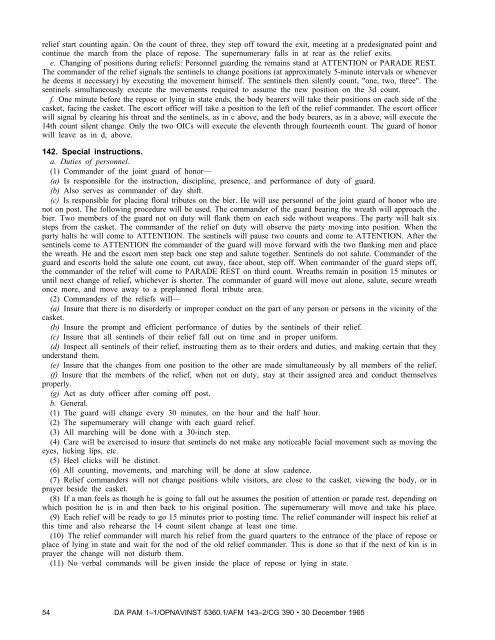state, official, and special military funerals - Army Publishing ...
state, official, and special military funerals - Army Publishing ...
state, official, and special military funerals - Army Publishing ...
You also want an ePaper? Increase the reach of your titles
YUMPU automatically turns print PDFs into web optimized ePapers that Google loves.
elief start counting again. On the count of three, they step off toward the exit, meeting at a predesignated point <strong>and</strong><br />
continue the march from the place of repose. The supernumerary falls in at rear as the relief exits.<br />
e. Changing of positions during reliefs: Personnel guarding the remains st<strong>and</strong> at ATTENTION or PARADE REST.<br />
The comm<strong>and</strong>er of the relief signals the sentinels to change positions (at approximately 5-minute intervals or whenever<br />
he deems it necessary) by executing the movement himself. The sentinels then silently count, "one, two, three". The<br />
sentinels simultaneously execute the movements required to assume the new position on the 3d count.<br />
f. One minute before the repose or lying in <strong>state</strong> ends, the body bearers will take their positions on each side of the<br />
casket, facing the casket. The escort officer will take a position to the left of the relief comm<strong>and</strong>er. The escort officer<br />
will signal by clearing his throat <strong>and</strong> the sentinels, as in c above, <strong>and</strong> the body bearers, as in a above, will execute the<br />
14th count silent change. Only the two OICs will execute the eleventh through fourteenth count. The guard of honor<br />
will leave as in d, above.<br />
142. Special instructions.<br />
a. Duties of personnel.<br />
(1) Comm<strong>and</strong>er of the joint guard of honor—<br />
(a) Is responsible for the instruction, discipline, presence, <strong>and</strong> performance of duty of guard.<br />
(b) Also serves as comm<strong>and</strong>er of day shift.<br />
(c) Is responsible for placing floral tributes on the bier. He will use personnel of the joint guard of honor who are<br />
not on post. The following procedure will be used. The comm<strong>and</strong>er of the guard bearing the wreath will approach the<br />
bier. Two members of the guard not on duty will flank them on each side without weapons. The party will halt six<br />
steps from the casket. The comm<strong>and</strong>er of the relief on duty will observe the party moving into position. When the<br />
party halts he will come to ATTENTION. The sentinels will pause two counts <strong>and</strong> come to ATTENTION. After the<br />
sentinels come to ATTENTION the comm<strong>and</strong>er of the guard will move forward with the two flanking men <strong>and</strong> place<br />
the wreath. He <strong>and</strong> the escort men step back one step <strong>and</strong> salute together. Sentinels do not salute. Comm<strong>and</strong>er of the<br />
guard <strong>and</strong> escorts hold the salute one count, cut away, face about, step off. When comm<strong>and</strong>er of the guard steps off,<br />
the comm<strong>and</strong>er of the relief will come to PARADE REST on third count. Wreaths remain in position 15 minutes or<br />
until next change of relief, whichever is shorter. The comm<strong>and</strong>er of guard will move out alone, salute, secure wreath<br />
once more, <strong>and</strong> move away to a preplanned floral tribute area.<br />
(2) Comm<strong>and</strong>ers of the reliefs will—<br />
(a) Insure that there is no disorderly or improper conduct on the part of any person or persons in the vicinity of the<br />
casket.<br />
(b) Insure the prompt <strong>and</strong> efficient performance of duties by the sentinels of their relief.<br />
(c) Insure that all sentinels of their relief fall out on time <strong>and</strong> in proper uniform.<br />
(d) Inspect all sentinels of their relief, instructing them as to their orders <strong>and</strong> duties, <strong>and</strong> making certain that they<br />
underst<strong>and</strong> them.<br />
(e) Insure that the changes from one position to the other are made simultaneously by all members of the relief.<br />
(f) Insure that the members of the relief, when not on duty, stay at their assigned area <strong>and</strong> conduct themselves<br />
properly.<br />
(g) Act as duty officer after coming off post.<br />
b. General.<br />
(1) The guard will change every 30 minutes, on the hour <strong>and</strong> the half hour.<br />
(2) The supernumerary will change with each guard relief.<br />
(3) All marching will be done with a 30-inch step.<br />
(4) Care will be exercised to insure that sentinels do not make any noticeable facial movement such as moving the<br />
eyes, licking lips, etc.<br />
(5) Heel clicks will be distinct.<br />
(6) All counting, movements, <strong>and</strong> marching will be done at slow cadence.<br />
(7) Relief comm<strong>and</strong>ers will not change positions while visitors, are close to the casket, viewing the body, or in<br />
prayer beside the casket.<br />
(8) If a man feels as though he is going to fall out he assumes the position of attention or parade rest, depending on<br />
which position he is in <strong>and</strong> then back to his original position. The supernumerary will move <strong>and</strong> take his place.<br />
(9) Each relief will be ready to go 15 minutes prior to posting time. The relief comm<strong>and</strong>er will inspect his relief at<br />
this time <strong>and</strong> also rehearse the 14 count silent change at least one time.<br />
(10) The relief comm<strong>and</strong>er will march his relief from the guard quarters to the entrance of the place of repose or<br />
place of lying in <strong>state</strong> <strong>and</strong> wait for the nod of the old relief comm<strong>and</strong>er. This is done so that if the next of kin is in<br />
prayer the change will not disturb them.<br />
(11) No verbal comm<strong>and</strong>s will be given inside the place of repose or lying in <strong>state</strong>.<br />
54 DA PAM 1–1/OPNAVINST 5360.1/AFM 143–2/CG 390 30 December 1965
















